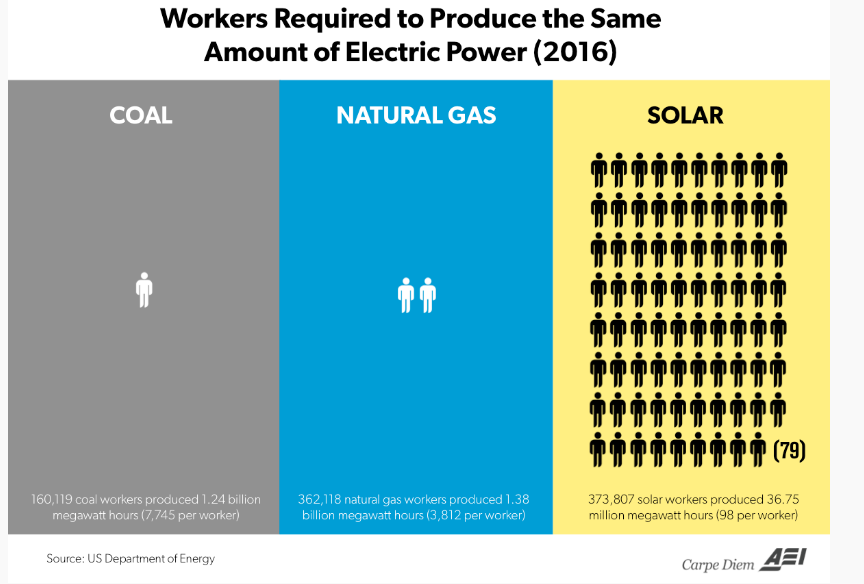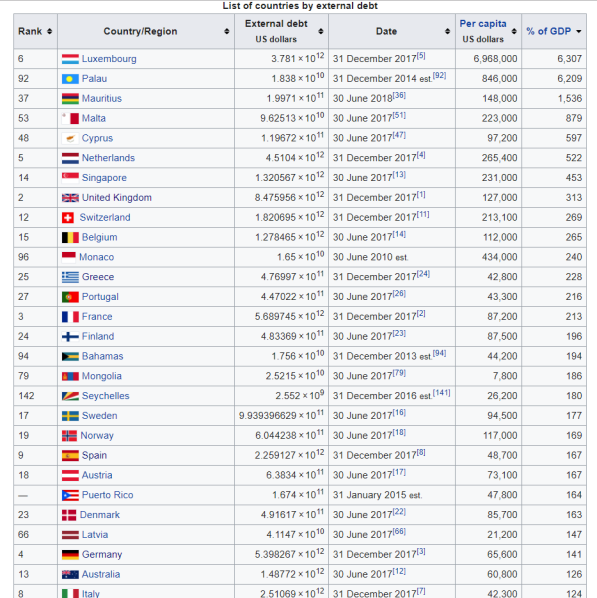The four key problems with solar panels

There are four key problems with solar panels, the first being efficiency, the second being labor requirements, the third being price, and the fourth being the variability of the weather. The most obviously problematic of them all, which
all sides seem to agree on, is the massive labor requirements. Solar panels require
approximately 79 times the labor as coal to function correctly; as solar panels currently only produce 1.32% of our nation's power as of 2016 [
2], but utilize 374,000 workers [
3], in comparison to fossil fuels like coal and gas at 62% of our electricity and 1.1 million workers, and nuclear power which produces approximately 20% of our power and 120,000 workers. To replace coal, nuclear power and all other forms of electricity you'd need 75 times the amount of solar power generation, and accordingly 374,000 x 75 times the workers, or 28 million people. This would require approximately 10% of our population to work on solar power generation, which is an impossibly high amount of salary costs and labor input to functionally work for our society, and that's before getting in to trying to replace gasoline and other sources of power like natural gas for heating or cooking that is also present, that could easily double this requirement. As electricity only makes up approximately one third of energy consumption, when other forms of energy are considered (gasoline for cars, natural gas for heating etc.), it could possibly take up to 30% of our country becoming solar panel workers to completely replace all energy production with solar panels. It's just not practical to expect people to abandon their jobs and learn how to become a solar worker in these volumes, or pay for it, let alone for something with so little real world benefit, being more expensive and polluting as much.
Fundamentally beyond this, is energy efficiency, as the problem with solar panels being posited as "clean" energy is they're not particularly efficient or clean. Solar panels obviously do not come from thin air, and it's not just a matter of money or cost to create them. It takes an enormous amount of electricity produce solar panels, requiring the electrocution of sand at the right stages in order to turn it in to glass, with the same high energy requirements for producing their batteries. The solar panel industry consumes large amounts of electricity in the aggregate for solar panels to be created, and industry as a whole barely produces more electricity than it creates. Only
recently has the industry surpassed the bench mark of producing more energy than it consumes, as of 2014, and this is largely due to superior placement of solar panels (in sunnier areas), and the use of more expensive materials. Regardless, this means that, if we were for instance to burn all the world's coal to create solar panels, we might get slightly more energy out after 30 years than we put in to it, or 10-20% more energy, which wouldn't be enough to justify the cost, labor requirements, weather variability and other problems. If we used nuclear power or another clean source of energy to create solar panels, we would be better off using this clean source of power to power society than dramatically increase the price and labor for a less efficient weather dependent system. This efficiency is set to improve in the future, largely due to better placement of solar panels (I.E. placing them in sunny areas), but nonetheless as a whole it still barely produces more than it consumes. We would first need a source of clean, abundant energy to reliably make solar panels, such as uranium in CANDU reactors, which if we had that, our problems would already be over. The added expense and difficulty of creating solar panels to gain slight bit of extra power during the summer likely is not worth it. Solar panels at their current levels of efficiency also cannot create more of themselves, or are not self-sufficient, as they'd have to produce twice as much as they consumed to be able to do that, that is to have enough power both to run society
and make more solar panels, and even at this level it would not compensate for problems like very little sunlight during the winter and lots of sunlight during the summer.
Solar panels also have extreme weather variability issues, such as failing to work when there is little sunlight, like during major storms or other dark periods. When it rains or is foggy for long periods of time, or if there is hail or strong winds which might damage solar panels, solar panels cannot work. Snow, rain, hail, and other such things can disrupt the use of solar panels, as can simple things like winter. During the winter, sunlight is limited, and so the use of solar panels is more limited and ultimately less effective. A solar panel with a high solar efficiency, sufficient to power society at an "average daily solar output rate" on paper, is not enough in reality, as during the winter there would be less sunlight than the "daily average", and thus there is an intrinsic need for more solar panels. So, for a society to be able to use solar panels, they would need to reach a certain minimum to compensate for the winter and other dark periods. During the winter, you might need 2-3 times as many solar panels as you'd need during normal times, and thus would necessitate over twice as many solar panels than one would ordinarily need during an "average" day. As there is no consistent daily solar output, we would need to produce more solar panels than are needed on the "average day", meaning that even if we got to the perfect level of efficiency we needed based on average solar daily levels, we'd actually need more than twice as many solar panels to compensate during the winter. An example of such a problem is in Germany, who when attempting to power an entire city and large volumes of their country with solar panels, found they produced far too little power in the winter, but produced far more than they needed in the summer. [
4][
5][
6] This german city found it almost impossible to power their city on pure solar panels, and found massive power surpluses during the summer and shortages during the winter; even if we wanted to build enough for winter, the amount of solar panels needed would be 3 times or more than what is normally necessary, so solar panels at best can augment existing power systems and not be a total replacement for them.
Batteries, which are needed for solar panels and, also electric cars, largely have their costs come from the price of electricity, so with higher electricity costs comes more expensive electric cars. But solar panels are not cheap regardless. They tend to be far more expensive than fossil fuels or nuclear power, although the price varies given location (places with more sunlight generate more solar power), subsidies, if
power storage is present (such as batteries), and the type of solar power generation process. Solar panel prices vary considerably, and information about the real price of solar panels is often diluted because of this; for example, roof installation solar panels cost approximately 253 dollars per mw/h, while the cheapest variant of solar panels cost 49.5 per mw/h, and coal can cost 101.5 dollars per megawatt hour. However, solar panels are often subsidized and are only useful if storage mechanisms are present, therefore being responsible for the low cost of a very specific and particular form of solar power. Cheap solar panels are not protected against hail or other weather problems, and often are not efficient enough to produce more energy than they consume. Even if the cheapest form of solar power is chosen, it still invariably will likely prove to be problematic in some other way. Government subsidies *might* make it cheap enough for your average citizen to uses, but this cost is still paid by society, making the benefit essentially irrelevant, and only conceals the problem. For technology industries that consume high levels of electricity and who's prices are based on electricity prices, such as carbon fiber plants or computer manufacturers, solar would unnecessarily hemorrhage their profits and cause costs to sky rocket for these products. Government subsidies for coal or uranium might pay for relatively small start up costs, but do not pay for their entire operation, where as solar subsidies tend to pay for virtually the entire cost of solar power. Even so it's still proven to be fairly expensive, and this does not solve the problem to society itself; we still end up paying for higher electricity even if it's through a tax increase. Trading paying a company 4000 a year to trading the government 4000 a year does not change the costs requirements. Furthermore, it would be insufficient for large businesses who rely on electricity and consume the majority of our electricity, and bare in mind this massive increase in cost comes with massive labor requirements, variability in bad weather, and an only slightly mild increase in total energy output. In the end, solar panels are not a replacement for a decent clean, cheap energy source, like uranium or thorium. Comparatively, uranium could be as much as 6-8 times cheaper than coal, which would mean a technological revolution in this country allowing us to produce cheap technological goods and probably outsell china, making it the ideal choice.
Most Nuclear costs come from interest paid to banks on loans (70%) and insurance costs, two costs which can be easily eliminated through low interest loans and government provisions for any damage potentially caused by nuclear power. Rather than paying insurance companies enormous amounts of money on the potential of a total nuclear melt down, an event that has never occurred within the U.S., one could simply in the rare event shift the burden on to the government, and have the government provide low or no-interest loans for the start up cost, also ignoring the potential risk associated with nuclear. While the chance of a nuclear melt down is already low with American plants, with no serious melt down in U.S. history (with a few partial melt downs), and a melt down not leading to an explosion like in Chernobyl which was a steam explosion and not a nuclear bomb going off, CANDU reactors are incapable of having a melt down, and the coolant system itself would automatically shut down the chance of a nuclear reaction. Using .7% to 1.2% U235 uranium, the low volume of U-235 uraniumn makes a melt down impossible, as it's close to what is found in nature (which obviously isn't exploding at this moment). CANDU reactors are already 60% of the price of ordinary uranium reactors, so it is possible for the price to drop further. Other than the extremely low carbon emissions, it is also has the potential to be much cheaper and would be necessarily to make solar panels in any case. In short, there are better, more effective power sources available, and solar panels have proven to be hideously inefficient.

